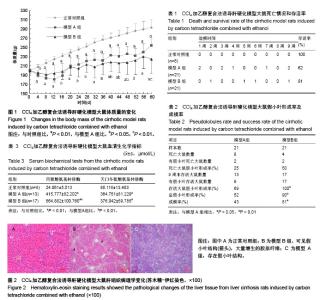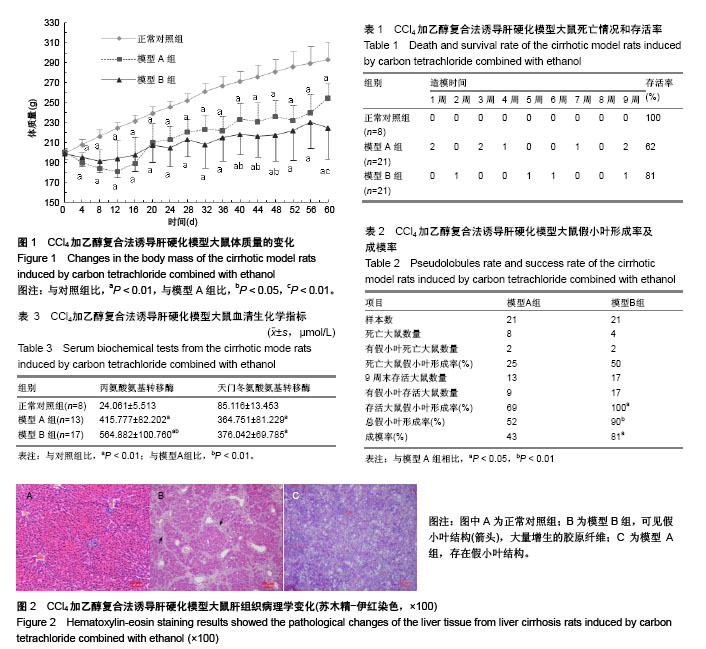Chinese Journal of Tissue Engineering Research ›› 2018, Vol. 22 ›› Issue (20): 3224-3229.doi: 10.3969/j.issn.2095-4344.0813
Previous Articles Next Articles
A rat model of liver cirrhosis induced by the combination of carbon terachloride and ethanol: establishment and verification
Bin Wen-ting1, Chang Jia-song1, Wu Jian-ping2
- 1Department of Human Anatomy and Histoembryology, 2Laboratory Animal Center, Nanjing University of Chinese Medicine, Nanjing 210023, Jiangsu Province, China
-
Received:2017-07-19Online:2018-07-18Published:2018-07-18 -
Contact:Chang Jia-song, Master, Associate professor, Department of Human Anatomy and Histoembryology, Nanjing University of Chinese Medicine, Nanjing 210023, Jiangsu Province, China -
About author:Bin Wen-ting, M.D., Lecturer, Department of Human Anatomy and Histoembryology, Nanjing University of Chinese Medicine, Nanjing 210023, Jiangsu Province, China -
Supported by:the Natural Science Foundation of Universities in Jiangsu Province, No. 13KJD310001
CLC Number:
Cite this article
Bin Wen-ting1, Chang Jia-song1, Wu Jian-ping2. A rat model of liver cirrhosis induced by the combination of carbon terachloride and ethanol: establishment and verification[J]. Chinese Journal of Tissue Engineering Research, 2018, 22(20): 3224-3229.
share this article
| [1] GBD 2013 Mortality and Causes of Death Collaborators. Global, regional, and national age-sex specific all-cause and cause-specific mortality for 240 causes of death, 1990-2013: a systematic analysis for the Global Burden of Disease Study 2013. Lancet. 2015;385(9963):117-171. [2] Liu F, Chen L, Rao HY, et al. Automated evaluation of liver fibrosis in thioacetamide, carbon tetrachloride, and bile duct ligation rodent models using second-harmonic generation/ two-photon excited fluorescence microscopy. Lab Invest. 2017;97(1):84-92. [3] 李异玲,傅宝玉,王炳元,等.实验化学性与酒精性肝纤维化大鼠动物模型的比较[J].中国医科大学学报,2005,34(1):25-27.[4] Ki SH,Park O,Zheng M,et al. Interleukin-22 treatment ameliorates alcoholic liver injury in a murine model of chronic-binge ethanol feeding: role of signal transducer and activator of transcription 3. Hepatology. 2010;52(4):1291-1300. [5] Wang P, Liang YZ. Chemical composition and inhibitory effect on hepatic fibrosis of Danggui Buxue Decoction. Fitoterapia. 2010;81(7):793-798. [6] Sun WY, Song Y, Hu SS, et al. Depletion of β-arrestin2 in hepatic stellate cells reduces cell proliferation via ERK pathway. J Cell Biochem. 2013;114(5):1153-1162. [7] Abdel-Rahman MK. Can apricot kernels fatty acids delay the atrophied hepatocytes from progression to fibrosis in dimethylnitrosamine (DMN)-induced liver injury in rats? Lipids Health Dis. 2011;10:114. [8] Honda H, Ikejima K, Hirose M, et al. Leptin is required for fibrogenic responses induced by thioacetamide in the murine liver. Hepatology. 2002;36(1):12-21.[9] Park SY, Shin HW, Lee KB, et al. Differential expression of matrix metalloproteinases and tissue inhibitors of metalloproteinases in thioacetamide-induced chronic liver injury. J Korean Med Sci. 2010;25(4):570-576. [10] Shi Y, Wang XH, Zhang HH, et al. Quantitative analysis of real-time tissue elastography for evaluation of liver fibrosis. Int J Clin Exp Med. 2014;7(4):1014-1021. [11] Sheen JM, Chen YC, Tain YL, et al. Increased circulatory asymmetric dimethylarginine and multiple organ failure: bile duct ligation in rat as a model. Int J Mol Sci. 2014;15(3): 3989-4006.[12] Tsuneyama K, Moritoki Y, Kikuchi K, et al. Pathological features of new animal models for primary biliary cirrhosis. Int J Hepatol. 2012;2012:403954. [13] Leung PS, Yang GX, Dhirapong A, et al. Animal models of primary biliary cirrhosis: materials and methods. Methods Mol Biol.2012;900:291-316. [14] 那坤,武亮,李滢,等.大鼠肝纤维化实验动物模型的建立方法[J].中国中医基础医学杂志,2015,21(3):272-274.[15] Proctor E, Chatamra K. High yield micronodular cirrhosis in the rat. Gastroenterology. 1982;83(6):1183-1190.[16] Gao TJ, Dong L, Shi HT, et al. Effect of alcohol extract of Plumula Nelumbini on carbon tetrachloride induced rat liver fibrosis: an experimental study. Zhongguo Zhong Xi Yi Jie He Za Zhi. 2014;34(12):1476-1480.[17] Iwaisako K, Jiang C, Zhang M, et al. Origin of myofibroblasts in the fibrotic liver in mice. Proc Natl Acad Sci U S A. 2014; 111(32):E3297-3305. [18] Sarhadi Kholari F, Dehpour AR, Nourbakhsh M, et al. Erythrocytes Membrane Alterations Reflecting Liver Damage in CCl?-Induced Cirrhotic Rats: The Ameliorative Effect of Naltrexone. Acta Med Iran. 2016;54(10):631-639.[19] Harris TR, Kodani S, Yang J, et al. An ω-3-enriched diet alone does not attenuate CCl4-induced hepatic fibrosis. J Nutr Biochem. 2016;38:93-101.[20] Chatamra K, Proctor E. Phenobarbitone-induced enlargement of the liver in the rat: its relationship to carbon tetrachloride- induced cirrhosis. Br J Exp Pathol. 1981;62(3):283-288.[21] Han XY, Hu JN, Wang Z, et al. 5-HMF Attenuates Liver Fibrosis in CCl4-Plus-Alcohol-Induced Mice by Suppression of Oxidative Stress. J Nutr Sci Vitaminol (Tokyo). 2017; 63(1):35-43.[22] Kojima-Yuasa A, Goto M, Yoshikawa E, et al. Protective Effects of Hydrolyzed Nucleoproteins from Salmon Milt against Ethanol-Induced Liver Injury in Rats. Mar Drugs. 2016;14(12). [23] Zhang F, Gu JX, Zou XP, et al. Protective effects of S-adenosylmethionine against CCl4 - and ethanol-induced experimental hepatic fibrosis. Mol Biol (Mosk). 2016;50(2): 284-290. [24] Zhang JJ, Meng XK, Dong C, et al. Development of a new animal model of liver cirrhosis in swine. Eur Surg Res. 2009; 42(1):35-39. [25] 韩德五,马学慧,赵元昌.肝硬化动物模型的研究[J].山西医药杂志,1979(4):1-6.[26] Chae HB, Jang LC, Park SM, et al. An experimental model of hepatic fibrosis induced by alcohol and CCl4: can the lipopolysaccharide prevent liver injury induced by alcohol and CCl4? Taehan Kan Hakhoe Chi. 2002;8(2):173-178.[27] Huang Q, Shi CC, Lin LY, et al. Expression and correlation of angiotensin-converting enzyme 2 in CCl4-induced rat liver fibrosis. Zhonghua Gan Zang Bing Za Zhi. 2013;21(1):47-52.[28] Li W, Wu Y, Zhu C, et al. Anti-fibrosis effects of Huisheng oral solution in CCl4-induced hepatic fibrosis in rat. Indian J Pharmacol. 2014;46(2):216-221. [29] 杨婷,范东旭,罗维.传统肝硬化动物模型制备方法的改良[J].黑龙江医药科学,2005,28(1):15-16.[30] Sharma S, Khalili K, Nguyen GC. Non-invasive diagnosis of advanced fibrosis and cirrhosis. World J Gastroenterol. 2014;20(45):16820-16830.[31] 郑佳连,卢秉久,黄松,等.活血祛湿方对纯化高脂饲料诱导大鼠非酒精性脂肪性肝炎模型的影响[J].中国实验方剂学杂志,2016, 22(7):144-149.[32] Goldschmidt I, Baumann U. Hepatic fibrosis in paediatric liver disease. Clin Res Hepatol Gastroenterol. 2012;36(3):268-270. [33] Starkel P, Leclercq IA. Animal models for the study of hepatic fibrosis. Best Pract Res Clin Gastroenterol. 2011;25(2): 319-333. [34] Domenicali M, Caraceni P, Giannone F, et al. A novel model of CCl4-induced cirrhosis with ascites in the mouse. J Hepatol. 2009;51(6):991-999. [35] French SW, Miyamoto K, Tsukamoto H. Ethanol-induced hepatic fibrosis in the rat: role of the amount of dietary fat. Alcohol Clin Exp Res. 1986;10(6 Suppl):13S-19S.[36] Lucey MR, Mathurin P, Morgan TR. Alcoholic hepatitis. N Engl J Med. 2009;360(26):2758-2769. [37] Albano E. Alcohol, oxidative stress and free radical damage. Proc Nutr Soc. 2006;65(3):278-290.[38] Roman S, Zepeda-Carrillo EA, Moreno-Luna LE, et al. Alcoholism and liver disease in Mexico: genetic and environmental factors. World J Gastroenterol. 2013;19(44): 7972-7982. [39] Bosma A, Brouwer A, Seifert WF, et al. Synergism between ethanol and carbon tetrachloride in the generation of liver fibrosis. J Pathol. 1988;156(1):15-21.[40] Su X, Wang Y, Zhou G, et al. Probucol attenuates ethanol-induced liver fibrosis in rats by inhibiting oxidative stress, extracellular matrix protein accumulation and cytokine production. Clin Exp Pharmacol Physiol. 2014;41(1):73-80.[41] Furuya S, Chappell GA, Iwata Y, et al. A mouse model of alcoholic liver fibrosis-associated acute kidney injury identifies key molecular pathways. Toxicol Appl Pharmacol. 2016;310: 129-139.[42] Mullen KD, McCullough AJ. Problems with animal models of chronic liver disease: suggestions for improvement in standardization. Hepatology. 1989;9(3):500-503.[43] Chen X, Yan R, Bai Z, et al. Enhanced sedative efficacy and delayed recovery in propofol anesthesia in a rat model of hepatic cirrhosis. Int J Clin Exp Med. 2015;8(4):5723-5730. [44] 郭花,薛挥.肝硬化动物模型研究进展[J].中国比较医学杂志,2006,16(8):499-501. [45] 张贵阳,杨卫平,陈皓.肝硬化动物模型构建的研究进展[J].外科理论与实践,2008,13(3):266-269.[46] 金峰,袁芳,薛建设,等.四氯化碳综合法诱导大鼠肝硬化模型方法的探讨[J].福建医药杂志,2003,25(5):127-128.[47] Hou YL, Tsai YH, Lin YH, et al. Ginseng extract and ginsenoside Rb1 attenuate carbon tetrachloride-induced liver fibrosis in rats. BMC Complement Altern Med. 2014;14:415. [48] Shen X, Cheng S, Peng Y, et al. Attenuation of early liver fibrosis by herbal compound "Diwu Yanggan" through modulating the balance between epithelial-to-mesenchymal transition and mesenchymal-to-epithelial transition. BMC Complement Altern Med. 20147;14:418. [49] Li W, Wu Y, Zhu C, et al. Anti-fibrosis effects of Huisheng oral solution in CCl4-induced hepatic fibrosis in rat. Indian J Pharmacol. 2014;46(2):216-221.[50] Shaaban AA, Shaker ME, Zalata KR, et al. Modulation of carbon tetrachloride-induced hepatic oxidative stress, injury and fibrosis by olmesartan and omega-3. Chem Biol Interact. 2014;207:81-91.[51] Semenov DE, Zhukova NA, Ivanova EP, et al. Hepatoprotective properties of betulonic acid amide and heptral in toxic liver injury induced by carbon tetrachloride in combination with ethanol. Bull Exp Biol Med. 2015;158(3): 336-341. [52] Domenicali M, Caraceni P, Giannone F, et al. A novel model of CCl4-induced cirrhosis with ascites in the mouse. J Hepatol. 2009;51(6):991-999. [53] Scholten D, Trebicka J, Liedtke C, et al. The carbon tetrachloride model in mice. Lab Anim. 2015;49(1 Suppl):4-11. [54] Bona S, Filippin LI, Di Naso FC, et al. Effect of antioxidant treatment on fibrogenesis in rats with carbon tetrachloride- induced cirrhosis. ISRN Gastroenterol. 2012;2012:762920.[55] Tsukamoto H, Matsuoka M, French SW. Experimental models of hepatic fibrosis: a review. Semin Liver Dis. 1990;10(1): 56-65.[56] Liu Y, Meyer C, Xu C, et al. Animal models of chronic liver diseases. Am J Physiol Gastrointest Liver Physiol. 2013; 304(5):G449-468. |
| [1] | Zhang Tongtong, Wang Zhonghua, Wen Jie, Song Yuxin, Liu Lin. Application of three-dimensional printing model in surgical resection and reconstruction of cervical tumor [J]. Chinese Journal of Tissue Engineering Research, 2021, 25(9): 1335-1339. |
| [2] | Chen Jiming, Wu Xiaojing, Liu Tianfeng, Chen Haicong, Huang Chengshuo. Effects of silymarin on liver injury and bone metabolism induced by carbon tetrachloride in mice [J]. Chinese Journal of Tissue Engineering Research, 2021, 25(8): 1224-1228. |
| [3] | Wang Hanyue, Li Furong, Yang Xiaofei, Hu Chaofeng. Direct reprogramming hepatocytes into islet-like cells by efficiently targeting and activating the endogenous genes [J]. Chinese Journal of Tissue Engineering Research, 2021, 25(7): 1056-1063. |
| [4] | Zeng Yanhua, Hao Yanlei. In vitro culture and purification of Schwann cells: a systematic review [J]. Chinese Journal of Tissue Engineering Research, 2021, 25(7): 1135-1141. |
| [5] | Xu Dongzi, Zhang Ting, Ouyang Zhaolian. The global competitive situation of cardiac tissue engineering based on patent analysis [J]. Chinese Journal of Tissue Engineering Research, 2021, 25(5): 807-812. |
| [6] | Liu Yang, Gong Yi, Fan Wei. Anti-hepatoma activity of targeted Pluronic F127/formononetin nanocomposite system in vitro [J]. Chinese Journal of Tissue Engineering Research, 2021, 25(4): 526-531. |
| [7] | Wu Zijian, Hu Zhaoduan, Xie Youqiong, Wang Feng, Li Jia, Li Bocun, Cai Guowei, Peng Rui. Three-dimensional printing technology and bone tissue engineering research: literature metrology and visual analysis of research hotspots [J]. Chinese Journal of Tissue Engineering Research, 2021, 25(4): 564-569. |
| [8] | Chang Wenliao, Zhao Jie, Sun Xiaoliang, Wang Kun, Wu Guofeng, Zhou Jian, Li Shuxiang, Sun Han. Material selection, theoretical design and biomimetic function of artificial periosteum [J]. Chinese Journal of Tissue Engineering Research, 2021, 25(4): 600-606. |
| [9] | Liu Fei, Cui Yutao, Liu He. Advantages and problems of local antibiotic delivery system in the treatment of osteomyelitis [J]. Chinese Journal of Tissue Engineering Research, 2021, 25(4): 614-620. |
| [10] | Li Xiaozhuang, Duan Hao, Wang Weizhou, Tang Zhihong, Wang Yanghao, He Fei. Application of bone tissue engineering materials in the treatment of bone defect diseases in vivo [J]. Chinese Journal of Tissue Engineering Research, 2021, 25(4): 626-631. |
| [11] | Zhang Zhenkun, Li Zhe, Li Ya, Wang Yingying, Wang Yaping, Zhou Xinkui, Ma Shanshan, Guan Fangxia. Application of alginate based hydrogels/dressings in wound healing: sustained, dynamic and sequential release [J]. Chinese Journal of Tissue Engineering Research, 2021, 25(4): 638-643. |
| [12] | Chen Jiana, Qiu Yanling, Nie Minhai, Liu Xuqian. Tissue engineering scaffolds in repairing oral and maxillofacial soft tissue defects [J]. Chinese Journal of Tissue Engineering Research, 2021, 25(4): 644-650. |
| [13] | Xing Hao, Zhang Yonghong, Wang Dong. Advantages and disadvantages of repairing large-segment bone defect [J]. Chinese Journal of Tissue Engineering Research, 2021, 25(3): 426-430. |
| [14] | Hao Xiaona, Zhang Yingjie, Li Yuyun, Xu Tao. Bone marrow mesenchymal stem cells overexpressing prolyl oligopeptidase on the repair of liver fibrosis in rat models [J]. Chinese Journal of Tissue Engineering Research, 2021, 25(25): 3988-3993. |
| [15] | Chen Siqi, Xian Debin, Xu Rongsheng, Qin Zhongjie, Zhang Lei, Xia Delin. Effects of bone marrow mesenchymal stem cells and human umbilical vein endothelial cells combined with hydroxyapatite-tricalcium phosphate scaffolds on early angiogenesis in skull defect repair in rats [J]. Chinese Journal of Tissue Engineering Research, 2021, 25(22): 3458-3465. |
| Viewed | ||||||
|
Full text |
|
|||||
|
Abstract |
|
|||||

